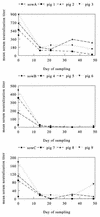Identification and characterization of a porcine torovirus
- PMID: 9557628
- PMCID: PMC109568
- DOI: 10.1128/JVI.72.5.3507-3511.1998
Identification and characterization of a porcine torovirus
Abstract
A porcine torovirus (PoTV) was identified and characterized; it is a novel member of the genus Torovirus (family Coronaviridae, order Nidovirales), closely related to but clearly distinct from the already recognized equine torovirus (ETV) and bovine torovirus (BoTV) representatives. Immunoelectron microscopy of feces from piglets revealed elongated, 120- by 55-nm particles which were recognized by a torovirus-specific antiserum. Amplification by reverse transcriptase (RT) PCR with primers designed to detect conserved regions (on the basis of the genomes of BoTV strain Breda and ETV strain Berne) resulted in the identification of the 489-bp nucleocapsid gene, encoding a 18.7-kDa protein. The sequence identity in this region between PoTV and both ETV and BoTV was only about 68%, whereas the latter two show 81% identity. Neutralizing antibodies directed against ETV were found in sera of adult and young pigs. In all 10 herds sampled, seropositive animals were present, and 81% of randomly selected adult sows possessed antibodies. A longitudinal study with RT PCR showed that piglets shed virus in the feces for 1 or more days, starting 4 to 14 days after weaning.
Figures





Similar articles
-
Molecular epidemiology of Porcine torovirus (PToV) in Sichuan Province, China: 2011-2013.Virol J. 2014 Jun 5;11:106. doi: 10.1186/1743-422X-11-106. Virol J. 2014. PMID: 24903213 Free PMC article.
-
Phylogenetic and evolutionary relationships among torovirus field variants: evidence for multiple intertypic recombination events.J Virol. 2003 Sep;77(17):9567-77. doi: 10.1128/jvi.77.17.9567-9577.2003. J Virol. 2003. PMID: 12915570 Free PMC article.
-
Torovirus detection in faecal specimens of calves and pigs in Hungary: short communication.Acta Vet Hung. 2002;50(3):293-6. doi: 10.1556/AVet.50.2002.3.5. Acta Vet Hung. 2002. PMID: 12237970
-
Bovine torovirus (Breda virus) revisited.Anim Health Res Rev. 2004 Dec;5(2):157-71. doi: 10.1079/ahr200498. Anim Health Res Rev. 2004. PMID: 15984322 Review.
-
[A review of porcine torovirus research: etiology and epidemiology].Bing Du Xue Bao. 2013 Nov;29(6):667-72. Bing Du Xue Bao. 2013. PMID: 24520775 Review. Chinese.
Cited by
-
Development of universal SYBR Green real-time RT-PCR for the rapid detection and quantitation of bovine and porcine toroviruses.J Virol Methods. 2010 Sep;168(1-2):212-7. doi: 10.1016/j.jviromet.2010.06.001. Epub 2010 Jun 15. J Virol Methods. 2010. PMID: 20558206 Free PMC article.
-
Genome sequence of torovirus identified from a pig with porcine epidemic diarrhea virus from the United States.Genome Announc. 2014 Dec 18;2(6):e01291-14. doi: 10.1128/genomeA.01291-14. Genome Announc. 2014. PMID: 25523767 Free PMC article.
-
The complete sequence of the bovine torovirus genome.Virus Res. 2006 Jan;115(1):56-68. doi: 10.1016/j.virusres.2005.07.005. Epub 2005 Aug 30. Virus Res. 2006. PMID: 16137782 Free PMC article.
-
VI, 1. Epidemiology of toroviruses.Perspect Med Virol. 2003;9:625-632. doi: 10.1016/S0168-7069(03)09038-4. Epub 2004 Sep 14. Perspect Med Virol. 2003. PMID: 32287605 Free PMC article.
-
Mechanism, structural and functional insights into nidovirus-induced double-membrane vesicles.Front Immunol. 2024 Jun 11;15:1340332. doi: 10.3389/fimmu.2024.1340332. eCollection 2024. Front Immunol. 2024. PMID: 38919631 Free PMC article. Review.
References
-
- Cavanagh D. Nidovirales: a new order comprising Coronaviridae and Arteriviridae. Arch Virol. 1997;142:629–633. - PubMed
MeSH terms
LinkOut - more resources
Full Text Sources
Other Literature Sources

